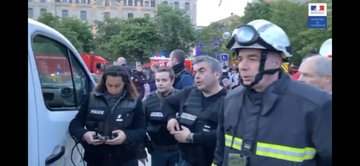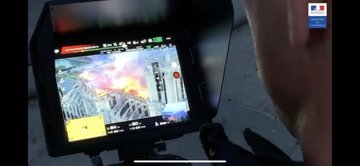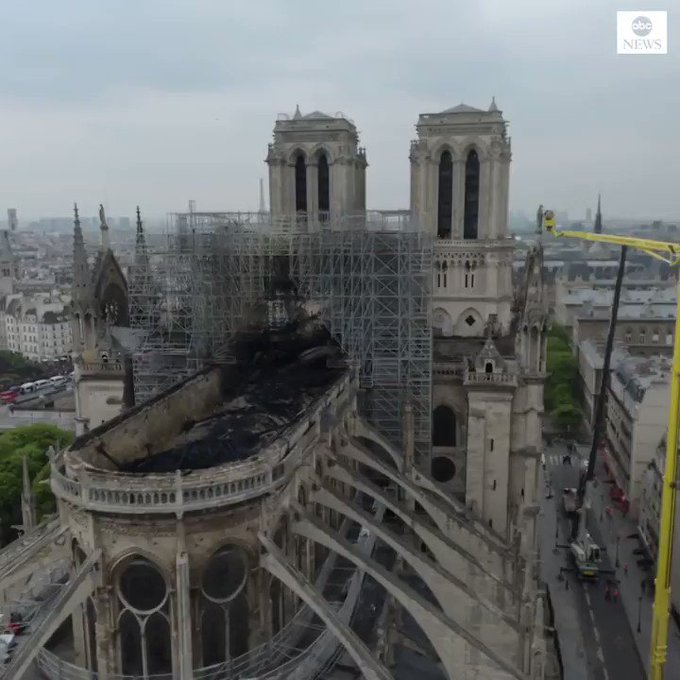Even in its original form, the Mavic Pro is still a highly accomplished (and much-loved) commercial model with flight times above 25 minutes and a range that would have kept its operators well out of danger. We’re not sure if the obstacle avoidance tech was necessary in this instance – also a feature of the M210 – but if it was being flown in unsurprisingly poor visibility then it’s never a bad thing!
The M210, part of the wider M200 Series, is a much more robust and professionally-oriented model, capable of carrying payloads of more than 4kg (flight times can vary from 24-38 minutes as a result) – though we don’t know what was in place in this instance. That said, the enhanced build would certainly have been better suited to the potentially dangerous flying conditions, with smoke, dust and water moisture all thick in the air. Plus it comes with a front-facing FPV camera, so it could have been nicely rigged up to a dual-operator system with one person flying the craft using the compatible DJI Goggles and another focusing purely on operating the camera systems – but we’re merely speculating at this point.
As both are DJI products, unsurprisingly the company has been following the coverage of events, with its Director of Public Safety Integration, Romeo Durscher saying that thermal cameras were NOT used – which would pour a little water on rumours that it was a Mavic 2 Enterprise Dual rather than a Mavic Pro in use (the former coming with the capacity to use and combine both visual and thermal imagery such as the Zenmuse XT camera, which the Mavic Pro can’t in its original form). The M210 could certainly have been equipped with a variety of sensors and payloads, though, so the pilots could have had plenty of options.
Firefighters Using Drones for Site Management
Although there are many ways in which drones can be used in such situations, the craft were predominantly used to, quite literally, give an overview of the fire – delivering video footage in real-time to those on the ground to help coordinate their efforts and apply the right tactics to contain and eventually put out the fire. Even without thermal imaging, both the Mavic Pro and the M210 could easily identify areas that were burning and be used to predict the fire’s path and send firefighters in accordingly. This footage was also used to help target the best places to aim the hoses and bring the raging fire under control in the most effective and efficient manner.
If thermal cameras were in operation then they could have been used to better identify hotspots (and conversely safe areas for fire crews to navigate) as well as peering through the smoke. Indeed these are areas where the drone itself comes into its own when compared to more costly aerial operations, where the likes of a helicopter wouldn’t have been able to get as close to the fire as the DJI models – in terms of mobility, safety, visibility and the simple fact that having the huge rotors of a helicopter blowing the fire and smoke around could wind up doing more harm than good.
Another point worth noting is that Paris, as a location, is notoriously strict on drone use, with most of the city a no-fly zone unless you have the relevant permissions. The models in question could also have used DJI’s own self-enforcing geofencing technologies in place that would have otherwise automatically prevented the drones from getting close to the cathedral. It could be assumed that craft linked to government departments might already have this disabled (there is also a Parisian Police Drone Unit which we’d imagine will have a little more freedom to fly), but DJI is staking a claim that it helped to remove any such geofencing restrictions as soon as it became aware of the blaze. DJI recently released the Qualified Entities Programme for Public Safety Organisations, allowing them to remove Geofencing restrictions so that they can respond to critical operations faster.
Drone Footage Shows Notre Dame Devastation
Drones Helped Make Tactical Decisions Quicker
With the fire taking some 12 hours to get fully under control, there are a variety of ways that drone technology could have been used during the incident. No doubt you’ll have seen plenty of aerial footage shot by drones, some during the fire and a lot more since highlighting the aftermath and scale of destruction that saw the spire and large sections of the roof destroyed – and we could give a list of ways that the firefighters and other professionals could have used UAV technology to help (as well as the 500kg ground-based robot that was sent into the heart of the fire as a mobile water cannon).
As mentioned, the firefighters themselves deserve all of the credit, but the use of drone technology hasn’t gone unnoticed in helping to save a lot of the building, including the iconic Gothic bell towers that stand at the front. Speaking to French media afterwards, firefighter spokesperson Gabriel Plus was reported to have said:
“It is thanks to these drones, to this new technique absolutely unavoidable today, that we could make tactical choices to stop this fire at a time when it was potentially occupying the two belfries… The drones allowed us to use our available means in the best possible way.”
This had led to plenty of positive news stories in the media highlighting the role that these drone played, and hopefully this will serve to help broaden the message of the good things that drones can do – especially for the emergency services in disaster and/or search and rescue situations. And it needn’t stop there…
Using Drones to Rebuild the Notre Dame Cathedral
We’ve mentioned the more recent aerial footage and photography showing the current situation, and there’s no reason why drone couldn’t be used to help in the rebuilding process. Simple scanning and photogrammetry can be used to create a more accurate visual picture of the cathedral as it now stands, with the likes of 3D mapping and BIM modelling taking those images to a new level when it comes to surveying and planning for the future of this world-famous landmark.
Although the positive news stories are all great to see and as sad as the Notre-Dame incident was, it does serve as a great example of how relatively simple drone technology can have a major impact on our everyday lives. Even back in 2015 during the horrific terrorist attacks on the French capital, there were reports of drones being used to track the suspects and monitor the situation in real-time.
Great photos and some cool inspection work is one thing, but having something in the boot of a car that could potentially save lives is something completely different. We’d certainly imagine that the Parisian Fire Brigade will be investing in a couple of models of its own in the near future!
And it needn’t just be for these bad news events either, with plenty of stories of drones being used to find missing people, or delivering rations and emergency medical supplies to isolated places. The key factor is that drones can be used to access areas that humans can’t, whether for practical or safety reasons. With even the simplest of cameras attached, they can provide valuable information in real-time to those on the ground, and in a far easier and less costly way than most of the alternatives. And when you begin to factor in some of the more complex systems, payloads and cameras, then the potential for drones to keep doing amazing things is truly vast – and it’s only going to get better and better. Credit Coptz



